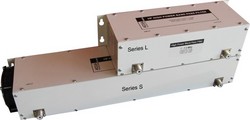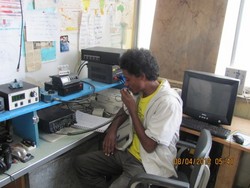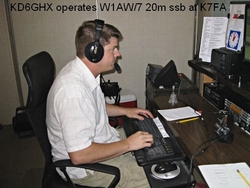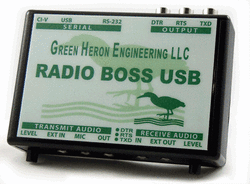 August 15, 2012 Editor: Ward Silver, NØAX | ||||||||||||||||||||||||||||||||||||||||||||||||||||||||||||||||||||||||||||||||||||||||||||||||||||||||||||||||||||||||||||||||||||||||||
IN THIS ISSUE
NEW HF OPERATORS - THINGS TO DO Don't miss the RTTY edition of the ARRL Rookie Roundup coming this Sunday afternoon! It's a great opportunity for you to exercise those digital muscles and learn a new mode or get better at RTTY contesting if you're already active on HF digital. Those of you licensed for a while can mentor a Rookie (or a team of Rookies in the new multioperator category) or if you haven't tried RTTY contesting, get the rig interfaced to your computer and have fun! BULLETINS There are no bulletins in this issue. BUSTED QSOS A golden issue last time! CONTEST SUMMARY Complete information for all contests follows the Conversation section Aug 18-19
Aug 25-26
The ARRL has recognized the four new Ontario sections announced by the RAC and shown in this map. The new sections will be used in the exchanges for this year's ARRL November Sweepstakes. Several vendors of regular and contest logging software have announced upgrade plans - please verify that the new VE3 section abbreviations (GTA, ONE, ONN, and ONS) will be supported well in advance of the ARRL Sweepstakes (Nov) and 160 Meter Contest (Dec), both of which use ARRL/RAC sections as multipliers. (Thanks, Doug Mercer VO1DTM/VO1DM CEC, RAC Chief Field Services Officer)
Rich VE3KI provides a convenient list of the the Ontario counties/districts/regional municipalities in the four new sections will be as follows:
How many stations from each section have been active? Well, here's how many were active last year:
There is a new CQ World Wide Contest rule: "13. Post-contest correcting of call signs by using any database, recordings or confirming QSO's is not allowed (Rule XII.2 always applies)" reads the new language in the CQ rules. From the radio-sport.net article about the rule change, "The message there is very clear, that post-contest log cleanup by using outside aid - whether it is call sign databases or recordings of the contest are now clearly considered against the rules." Let's not make this too complicated - identify your station, log what is sent, send the complete exchange, and don't change your log after the contest except for notes made during the contest period. Period. Along with the new rules and the shorter log submission deadline noted in the previous issue of this newsletter, CQ magazine will be publishing contest results as much as four months sooner than at present. The new schedule will be phased in over the course of 2013 and will be fully in place by 2014. Editor Dick Moseson W2VU notes, "For one year only (2013), the CQ World Wide VHF Contest results will be published in CQ VHF magazine, and will return to CQ as of 2014, appearing in the January issue." Jim AD1C reports that, "The Country (CTY) files were updated on 10 August 2012. To install the file, follow the link to your software at the top of the page." A bigger CTY.DAT is also available for everyday logging."
InnovAntennas is now stocking and supporting the Sky Sat Communications filter products and will be making available the balance of the product line during the second half of 2012. Available immediately are the High Power 5-pole and 3-pole Monoband Band Pass Filters (Series S & Series L) for the HF contest bands: 80m, 40m, 20m, 15m and 10m, and the High Power HF Triplexer/Combiner. All 4O3A filters, including the Triplexer/Combiner, are rated for full legal power at high duty cycle modes such as RTTY. (Thanks, Bill AA7XT) The semi-annual July 2012 report to the ARRL Board by the Contest Advisory Committee is available online. A list of your CAC and VUAC representatives is also available for your thoughts and suggestions. The Elecraft KX3 checked in at the very top of the Sherwood Engineering receiver rankings. The performance of this small radio that you can hold in your hand is pretty amazing - strong work by the SDR design team! ARRL Lab Manager, Ed Hare W1RFI notes that if you would like more information about these measurements, check out this 2004 QST article and the ARRL Lab Test Procedures Manual.
The 902 MHz edition of the Fall VHF Sprints has been moved to September 29 from its original October date. (Thanks, Bruce NT4RT) The DX Sherlock web site of real-time QSO maps has a new URL: www.dxmaps.com. (Thanks, Dave N7DB) The NCDXF, Northern California DX Foundation, has two new directors: ND2T, Tom Berson and K6NA, Glenn Rattmann. You have worked these two fellows from numerous DXpeditions and in lots of contests over the years. Congratulations to both and thanks for your service to the DX and contest communities! Web Site of the Week - Yes, there was a time when presentations about expeditions and ham radio did not begin with "Here we are at the airport..." For an example of those days when no scientific expedition worth its salt was without a ham, check out this article on Admiral Byrd's South Pole trip by John AE5X! WORD TO THE WISE Lockout - a device, hardware or software, that prevents a multi-operator, single-transmitter entry from transmitting more than one signal at a time.
Sandy N7RQ has just finished an update of the Arizona Outlaws Contest Club website detailing all of the recent W1AW/7 activity in the IARU HF Championship. On the home page, scroll down to the tabulation of W1AW/7 statistics and as instructed, "Click on a station, operator or score below to learn more and see exclusive photos". It sounds like everybody had a great time handing out the multiplier and putting W1AW on the air all across the state. (Thanks, Bob K8IA) Raytheon has announced its new "Space Fence" radar system for tracking the innumerable tiny bits of space junk in orbit. The existing Air Force Space Surveillance Radar in Texas provides some neat opportunities to listen in on meteor pings as described on Spaceweather.com. With the Perseid meteor shower still active, take a listen and see if you can hear some of the music of the spheres. (From AMSAT Bulletin ANS-225) We'll be seeing a lot of this code for the coming months as the Mars Rover, Curiosity, generates the Morse characters for "JPL" in its wheel tracks. In theory it's for distance calibration as Doug K1DG describes in his EDN blog - but we all know it was a great hack, too! (Thanks, Paul AA9GG) Online certificates for the CQ WPX Contest SSB/CW have been enhanced to provide separate certificates for those entrants that participated in one of the Overlay categories (Tribander/Single-Element or Rookie). Online certificates are available for all entries from 2007 and later. Go to the online score database and search for your entry. Follow the [Cert] link at the right side of the score line to go to the Certificates page. Entrants that entered their log in an Overlay category will see a second link on the certificate printing page that enables them to view their Overlay category certificate. (Thanks, CQ WPX Director, Randy Thompson, K5ZD)
Stan EI6DX/UA1OUT has just released a big report analyzing the 2011 CQ World Wide contests. The website has a "live" analyzer and there are lots of statistics on the contests from 2007 through 2011 that make fascinating reading. Bob N6TV finds, "...to me the most useful and fun is to seethe band openings to a specific area, from a specific area and gives the following instructions: Tack JE1CKA has uploaded the 2011 JIDX-PHONE contest results to the web. He reports that the 2012 JIDX-CW results will be available in a month or so.
Bank Error In Your Favor - CQ magazine reports that a glitch in the software used to analyze logs submitted for the CQ World Wide DX Contest has resulted in errors in final scores for some participants in the 2011 CQWW DX SSB and CW competitions. (No earlier contests were affected.) The errors - in which a good call sign was flagged as bad - do not affect the order of finish except in very rare instances and correcting the error actually raises scores. Corrected scores for the SSB contest have been posted with CW scores to follow. The photos, scores, and prize winners of the WRTC Station Test during the IARU HF Championship are now available. WRTC 2014 Co-Chair, Randy K5ZD says, "The station tests provided everything the organizing committee was looking for. We learned a lot, we have a list of things to improve, and we are more excited than ever to host a great event in 2014. If you won one of the prizes for contacting the WRTC test stations, please send an email to mailto:k5zd@wrtc2014.org to claim your prize." Adventure Radio Society Spartan Sprinters took to the airwaves the evening of August 6 for the eighth SP of 2012. In the Skinny Division, Andy MacAllister, W5ACM, of Houston, Texas, took top honors with 64 QSOs per pound. Remarkable! Topping the Tubby Division is John Laney, K4BAI, of Columbus, Georgia who amassed 40 contacts. (Thanks, Richard KI6SN) OPERATING TIP In the past, there has been some confusion about Rookie Roundup participants identifying properly. This is particularly important when the Rookie is a Technician operating on the HF bands. If you are a Rookie holding a Technician class license, you can either identify using the control operator's call sign or by using your call sign followed by a slash character (this weekend is the RTTY edition of Rookie Roundup) and the call sign of the control operator. For example, to use my station with me being the control operator, Technician class operator KDØSJF must identify as "NØAX" or as "KDØSJF/NØAX". (The latter assumes that I have "loaned" KDØSJF my station for the duration of the contest but am still acting as control operator.) The applicable FCC rule is 97.119. If you hear a Technician call sign operating outside the Technician class privileges, don't be rude - politely inform them that they must use the call sign of the control operator as described in rule 97.119. The SB-1000 linear amplifier is a good candidate for conversion to 6 meters as described by Bill W6WRT. "I used the technique of stepping down the plate impedance with a small inductor so I could use the original tune and load capacitors. (I also) homebrewed a new tank coil, plate choke and filament choke and installed a pi-net impedance matching circuit in the input." Pictures of the converted amplifier are available online. The photos of ebay item 110932148153 show a great way to re-use some of the old computer cases stacked up in your garage or basement. While we're on the subject, watch for the terrific cabinets and enclosures of obsolete lab equipment and instruments at swap meets. They are incredibly sturdy and very well made - a new equivalent would cost hundreds of dollars. For the price of new front and back panels, you can have a terrific looking, heavy-duty cabinet. (Thanks, Paul KØUYA) The Instructables website and weekly project compendium just keep on producing a lot of fun projects from silly to sublime. Here are my favorites over the past month or so: Have you ever wondered just which satellite it is that you sighted sliding along the stars overhead on a dark night? Surprise, surprise - there's an app for that! WhatSat - Satellite Explorer helps you identify and learn about satellites that you see passing overhead in the night sky. It can also be used as a satellite spotting aid. The satellite catalog includes 150 or so of the brightest orbiting objects as identified by NORAD. For each satellite listed there is a description and an image (when available). You can tell which satellites are currently visible or when a specific satellite will be visible. Search for visible ISS passes and impress your friends! WhatSat requires cell service or WiFi to access the server that does satellite flyby calculations. (From AMSAT Bulletin ANS-225) Bill KB8WYP describes a useful tool, "I use a wire pulling tool called a "creep-zit" to pull radials under fallen trees and logs in the woods. I basically just take one a 6-foot long fiberglass rods (a little over 1/8" diameter), tape the radial to one end, and then I can push it under fallen debris easily. With a little practice you can even get around hidden obstructions in the ground this way.
Technical Web Site of the Week - Mark K6UFO spotted the new Radio Boss product from Green Heron Engineering. In line with Green Heron's universal rotator control box, Radio Boss integrates a number of different interfaces for different manufacturer protocols. This simplifies the problem of rig control and signal interfacing considerably. Another interesting product is the Green Heron Everywhere line of wireless relay and control interface links. Broom For Improvement The lead news story in this issue refers to four new sections created by the RAC and that will be making life interesting for the November ARRL Sweepstakes savants searching for their yearly Clean Sweep mug. We're all going to learn a lot about the geography of Ontario! This sort of thing has happened before - for example, in 2000 the West Central Florida section was created from the North and South Florida sections, leading to a lot of "West Central What?" comments on the air. In light of the sudden interest in where sections come from and how they were added to (or subtracted from) the Clean Sweep threshold, Ken Harker WM5R took it upon himself to collect this issue's interesting history of the Sweepstakes sections - read on! 73, Ward NØAX The first "All-Section Sweepstakes" was held in January, 1930 and there were 68 sections. In addition to the sections we know today, there were some interesting differences. The ARRL Field Organization actually covered four countries at the time: the US, Canada, Newfoundland and Labrador, and Cuba. The US territorial possession of the Philippine Islands was its own section (part of the Pacific Division). But the most interesting of the 68 sections in 1930 was probably Georgia-South Carolina-Cuba-Isle of Pines. The Isle of Pines is an island off the coast of Cuba (today known as Isla de la Juventud or Isle of Youth). After the Spanish-American War was concluded in 1898, the sovereignty of the island remained in dispute. American commercial agricultural interests on the island urged the US to pursue a claim on the island against the newly independent Cuba. However, the U.S. Senate ratified a treaty recognizing Cuban sovereignty over the island in 1925. Nonetheless, "Isle of Pines" continued to show up in the ARRL section list until 1940.
15 August through 28 August An expanded, downloadable version of QST's Contest Corral in PDF format is available. Check the sponsor's Web site for information on operating time restrictions and other instructions. HF CONTESTS ARRL 10 GHz and Up Contest-- Phone, CW, Digital, from Aug 18, 6 AM to Aug 19, 12 AM. Bands (MHz): 10G+. Exchange: 6-character grid locator. Logs due: Oct 19. Rules ARRL Rookie Roundup-- Digital, from Aug 19, 1800Z to Aug 19, 2359Z. Bands (MHz): 3.5-28. Exchange: Both calls, name, check, S/P/XE or "DX". Logs due: See website. Rules North American QSO Party-- Phone, from Aug 18, 1800Z to Aug 19, 0600Z. Bands (MHz): 1.8-28. Exchange: Name and state. Logs due: 14 days. Rules NAQCC Monthly QRP Sprint-- CW, from Aug 15, 0030Z to Aug 15, 0230Z. Bands (MHz): 3.5-14. Monthly on 2nd Tuesday or 3rd Wednesday local time (alternating). Exchange: RST, S/P/C, and NAQCC member number or power. Logs due: 4 days. Rules Dominican Republic Contest-- Phone, from Aug 18, 0000Z to Aug 19, 2359Z. Bands (MHz): 3.5-7. Exchange: RS and serial. Logs due: Sep 2. Rules http://www.hi8ud.org SARTG WW RTTY Contest-- Digital, from Aug 18, 0000Z - see website. Bands (MHz): 3.5-28. Multiple operating periods. Exchange: RST and serial. Logs due: Oct 10. Rules Russian District Award Contest-- Phone, CW, from Aug 18, 0800Z to Aug 19, 0800Z. Bands (MHz): 1.8-28. Exchange: RS(T), serial or Russian district. Logs due: 30 days. Rules Keymen's Club of Japan Contest-- CW, from Aug 18, 1200Z to Aug 19, 1200Z. Bands (MHz): 1.8-28, 50. Exchange: RST and JA pref/dist or continent. Logs due: Sep 21. Rules Feld-Hell Gridloc Sprint-- Digital, from Aug 18, 2000Z to Aug 18, 2200Z. Bands (MHz): 1.8-28. Monthly on 3rd Saturday. Exchange: RST, S/P/C, Feld-Hell nr, 4-char grid square. Logs due: 7 days. Rules SARL Digital Contest-- Digital, from Aug 19, 1300Z to Aug 19, 16009Z. Bands (MHz): 3.5-14. Exchange: RST and serial. Logs due: 7 days. Rules Run For the Bacon-- CW, from Aug 20, 0100Z to Aug 20, 0300Z. Bands (MHz): 1.8-28. Monthly on 3rd Sunday night (local). Exchange: RST, S/P/C, | ||||||||||||||||||||||||||||||||||||||||||||||||||||||||||||||||||||||||||||||||||||||||||||||||||||||||||||||||||||||||||||||||||||||||||














